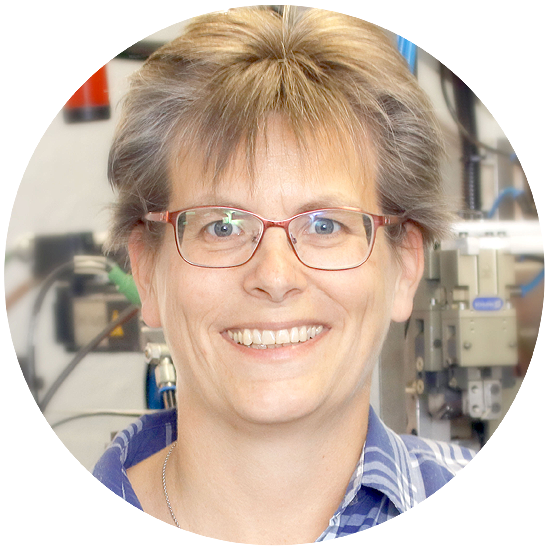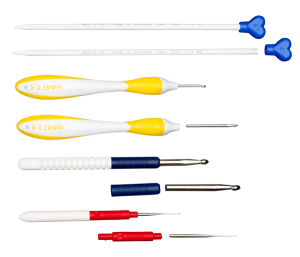Do you need a quotation or advice about our processes and services?
Our technical project manager Caroline Deutschmann, is happy to answer any of your questions.
Contact her directly at +49 (0)2352 9781 0

BONDING
BONDING METALS AND PLASTICS
Seltertech provides numerous options for bonding compounds together and offers skilled competency and knowledge in this area. We bond metals and plastics mainly in semi-automatic working environments, where the appropriate combination of individual components are verified directly by our staff.
Whether you’ve selected a similar or varying types of material combinations – bonding is almost always guaranteed with or without the appropriate pre-treatment, through our collaboration with leading adhesive manufacturers.
Using our new innovative adhesive device, we can easily apply a precise dose of glue to the adhering surface.
We offer mainly the following component pairings for gluing:
• Plastic – plastic
• Steel – plastic
• Aluminium – plastic
• Fine wood – aluminium
• Many other pairings
There are no limitations to the size and weight of the components to be bonded. However, the components should be movable without the aid of machines.
ESSENTIALS OF BONDING
PROCEDURE
Bonding is a joining process where virtually all types of materials can joined to each other using an adhesive.
An adhesive is a substance that sticks parts together by adhesion (surface adhesion) and cohesion (internal strength).
There is a wide variety of adhesives available for numerous areas of application. These include epoxies, polyurethanes and methacrylates.
A distinction is made between mono- and two-component adhesives.
Application of Mono-component adhesives (= 1-C adhesive)
These adhesives contain all the necessary components for bonding in one. This allows the adhesive to be applied directly from the cartridge, without adding or mixing other components into it.
Application of Two-component adhesives for bonding (= 2-C adhesive)
These adhesives consist of two separate components (hardener, also called activator and resin). Both components should be mixed together in the right proportions.
BASICS OF BONDING APPLICATION
A clean, dry surface is a prerequisite for perfect adhesion. Therefore, all substances such as oils, grease, paints or waxes that are sticking to the surface must be thoroughly removed with a releasing agent.
For optimal “anchoring” of the adhesive when bonding, it is best to treat the surface mechanically by sanding, grinding or sandblasting it, or with non-polar plastics (eg. B PE, PP, PTFE) that have been pretreated with a primer. The adhesive is always applied to one side in the amount needed. Otherwise, enough humidity can not penetrate.
The cure time for bonding is highly dependent on external factors, particularly temperature and humidity. An increase in temperature results in faster reactions and usually higher durability; the reaction rate decreases during cooler temperatures
.
TECHNICAL PARAMETER
Pot life
The remaining “open time” before the adhesive sticks to the surface.
Adhesion
A process where bonding agents stick to the surfaces of the joining parts. The binding strength among the molecules of a solid material are balanced. Some bindings may be exposed at the edge during this process. If another substance comes close enough, it might get within the effective range of these forces.
Cohesion
This is the ultimate strength of an adhesive after hardening. It occurs when long, thread-like molecular chains are “felted” together.
Curing
The period, in which the adhesive joint is exposed to heat and/or pressure for it to be set.
Moisture curing
The polymerization of these adhesives is caused in most cases by a reaction with atmospheric humidity.
Elasticity
The ability of a material to stretch when pressure is applied and then return to its original form when this pressure is removed.
ADVANTAGES
Bonding is particularly mild, since it does not require much heat, which can result in the delay, cooling stresses or structural changes of the assembled components. When gluing, it is not necessary to attenuate the holes of the joining parts, as is done with bolting and riveting. Additionally, the bonding strength is extensively transferred from one joining part to the other.
DIFFERENT TYPES OF ADHESIVES
EPOXY
Epoxy resin adhesive is made of resin and hardener; the hardening process is usually an exothermic reaction (heat is released). The heat generated from this bonding process causes the mixture to liquefy. There are different fast setting epoxies – depending on the application requirements. Curing takes place at room temperature, but is accelerated by heat. The higher the temperature, the shorter their curing time and the greater their full strength.
Advantages of epoxides:
- Bonding metal, ceramic, glass, stone, wood, fibre composites, hard plastics and many more.
- Good adhesiveness to many substrates
- Especially suitable for high-strength metal compounds
- Heat resistance
- Chemicals and age resistance
- Low odour, since no volatile substances are processed
- Low creep tendency and cure shrinkage
- Flexibility, elasticity and gap filling
METHACRYLATE
2-component adhesive can become a polymer network with high durability within a very short time. The methacrylate causes a high degree of hardness, while the rubber elasticizes. The acid then brings the adhesion to a very high level.
Advantages of Methacrylates:
- Bonds metal, plastics, composites, ceramics, wood, and more.
- Simple application at room temperature
- Good chemical resistance
- Wide temperature application range and heat resistance
- High tenwhichply and fast setting
- Fast curing
- Flexible connections
POLYURETHANE
1-C or 2-C-adhesives which cure at room temperature. Component: PolyI (= adhesive) and isocyanate (hardener). Preferably used for surface bonding. Gap filling; flexible and elastic in its final state. The strength is not comparable to epoxides – but is elastic at the joining when glued.
Advantages of polyurethanes:
- Highly elastic and flexible
- Medium strength
- Heat resistant, even with materials of different thermal expansions
- Very good adhesion to numerous substrates
- Joint filling
CYANACRYLATE
1-component adhesive which are cured in seconds by humidity. Reactive adhesive means that the reaction initiation must proceed from the material to be bonded and the curing is done chemically. Cyanoacrylates lead to surfaces, which are slightly alkaline or electrically negative, for rapid polymerization (= cross-linking) of liquid products. In general, a surface coating with moisture is enough to initiate the reaction. Acidic or electrically positive surfaces can slow down or completely hinder the hardening process or surface drying. The rate of cure and the potential strength of the cyanoacrylates depend, not only on the component texture (material column, geometry, etc.) but also on the relative room humidity. Humidity levels below 30% have a retarding effect, while values > 80% can lead to shock hardening, which later translates into voltages and associated low strength, and ageing resistance.
Advantages of Cyanoacrylates:
- Solvent-free and easy application
- Temperature applications of -60 °C to +80 °C
- Universal spectrum of application
- High impact strength
- Flexibility
- Temperature change – and humid climate resistance
GUSTAV SELTER GmbH & Co. KG
Hauptstraße 2 – 6
58762 Altena
Germany
© COPYRIGHT 2016-2023 GUSTAV SELTER GMBH & CO. KG


